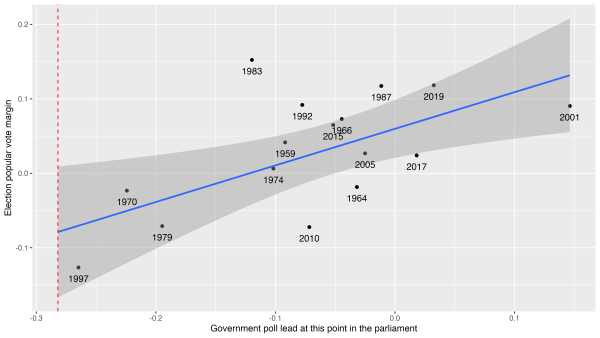
Why the Tories will almost certainly lose their majority at the next election
Patrick Flynn
20 October 2022
There is an oft-cited adage in politics that governments are at their most unpopular in the middle of their term as opposition poll leads shrink by the next election.
This is borne out by reality. We’re just over half way through the current parliament (assuming it runs to January 2025) and, based on historic trends, if the polls were neck-and-neck at this point, you would expect the government to win the popular vote at the next election by about six points.
However, the polls are not neck-and-neck and Labour are notching up record-breaking leads in recent surveys. Some have even argued that, given the methodological improvements polls have made in recent years, Labour’s margin right now could be the largest ‘real’ lead ever recorded in British polling.
A large mid-parliament opposition lead doesn’t automatically translate to victory, though, as scholars of the 1983 election will tell you. However, at this point in that cycle, Labour’s lead was 12 points, less than half their current figure. 1983 is also the most extreme example of a swing back to the government, propelled by the Labour-SDP split and improving economic conditions (and, in popular imagination, the Falklands War). Labour does not appear to be on the verge of a split, and economic conditions are set to worsen, not improve, in the near future.
One could easily use the 2010 election as a better comparison, when the Labour government, under a new PM facing a huge economic crisis, was ousted after more than a decade in office. During that cycle, there was no swing back to the government between the middle of the parliament and the end.
These two examples are at the extreme ends of the spectrum, but what does the general pattern tell us? Is Labour’s current position indicative of future success, and will the landslide polling numbers hold up?
Using PollBasePro, the invaluable dataset put together by Jack Bailey, Luke Mansillo and Mark Pack, we can compare how the polls looked at this point in the parliament (going back to 1955) with the subsequent election result.
Plugging Labour’s current lead into a simple linear regression, with more recent elections weighted more heavily, we can project a central estimate of an eight-point Labour popular vote victory at the next election, with an 89% chance that they win the most votes (though that estimate could be even higher given the forecasted economic circumstances).

The chance that the Tories hold onto their majority at the next election is very slim under this projection, at a 1-in-40 chance assuming a uniform swing in votes. Whether Labour goes on to win a majority may be a question of how efficient their vote share is.
On a uniform swing, assuming no change to the SNP vote in Scotland, Labour would need to lead the Conservatives by 12 points in the popular vote to get a majority, though the latest MRP poll by Opinium suggested Labour’s lead would only need to be around six points. However, these both presume the proposed boundary review, which would make things slightly harder for Labour, is not implemented.
Though a Labour landslide is well within the realms of possibility, the eight-point projected victory indicates that a small Labour majority or a hung parliament with Labour as the largest party looks like the most likely outcome right now.
However, these are not normal times. The economic circumstances faced by the current government are not likely to improve much before the next election, so you may want to revise Labour’s prospects up.
Patrick Flynn
20 October 2022


